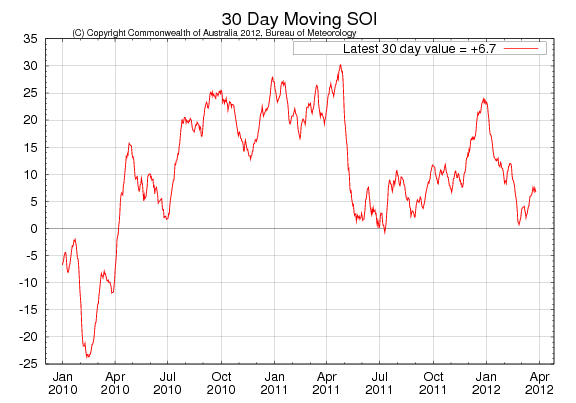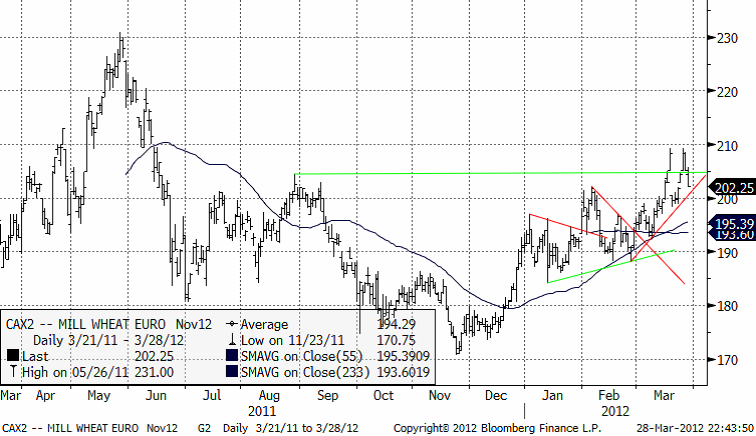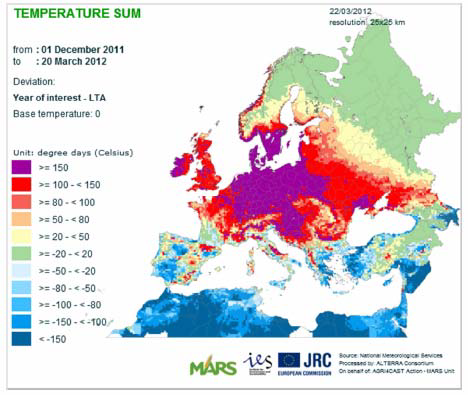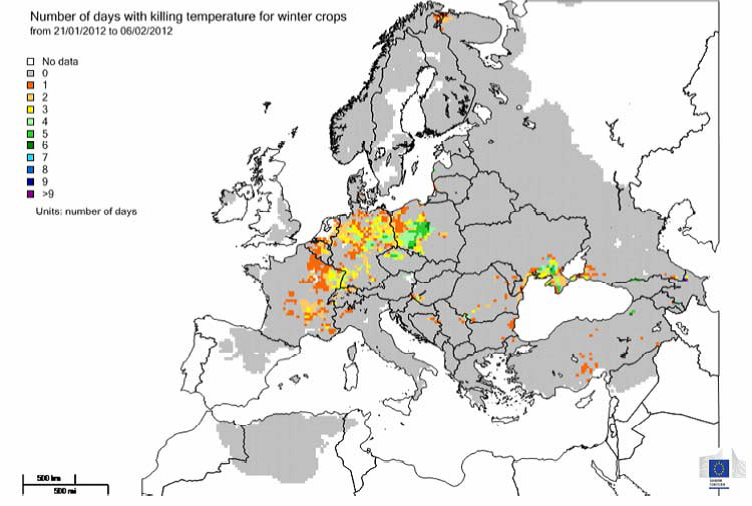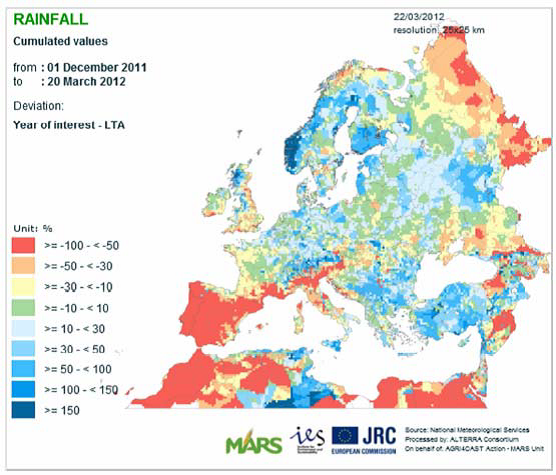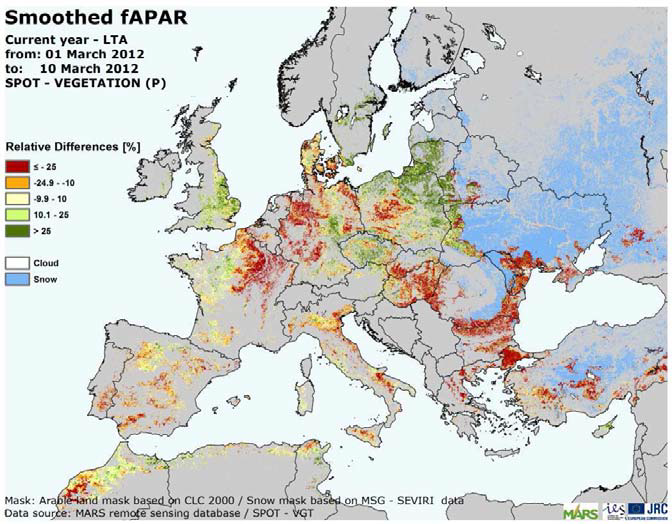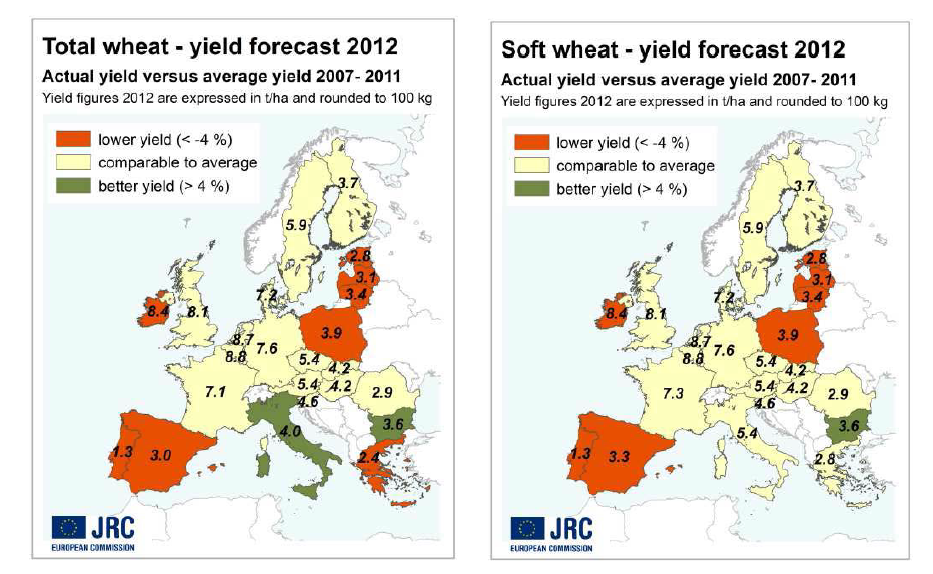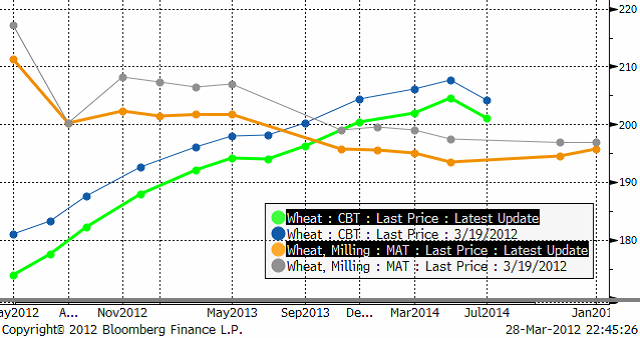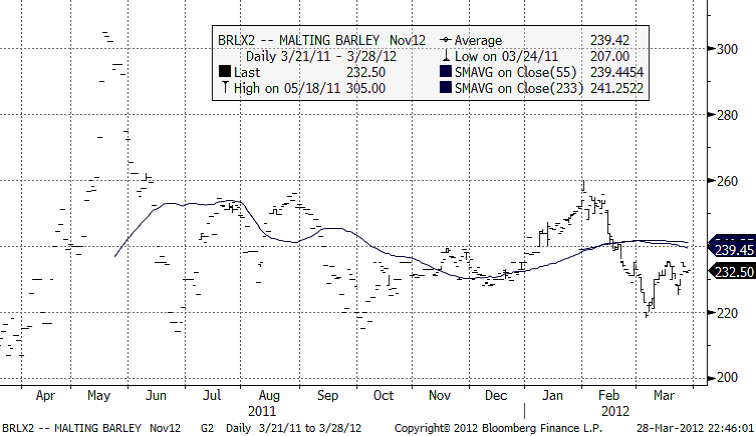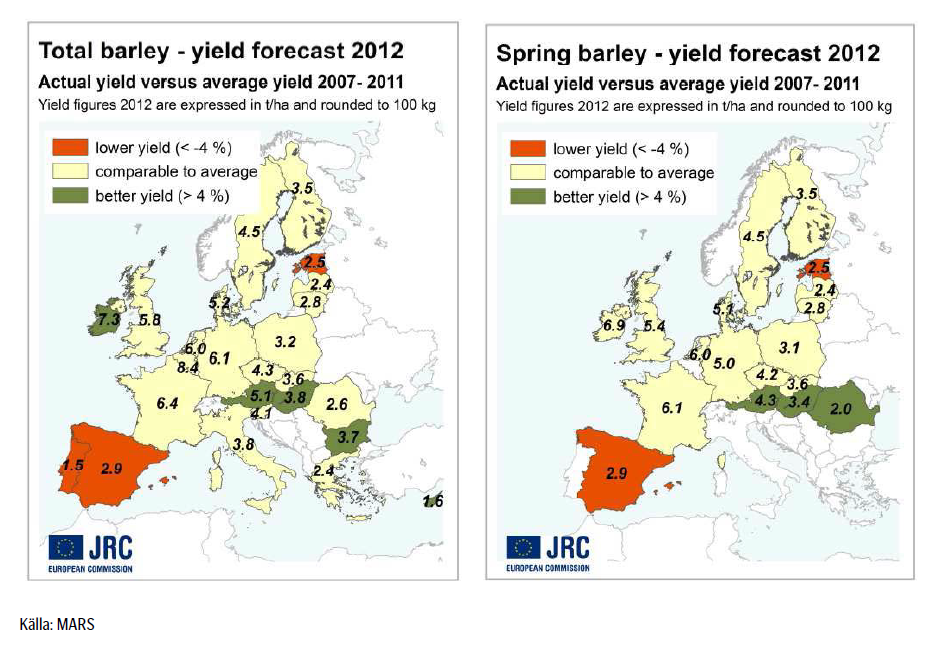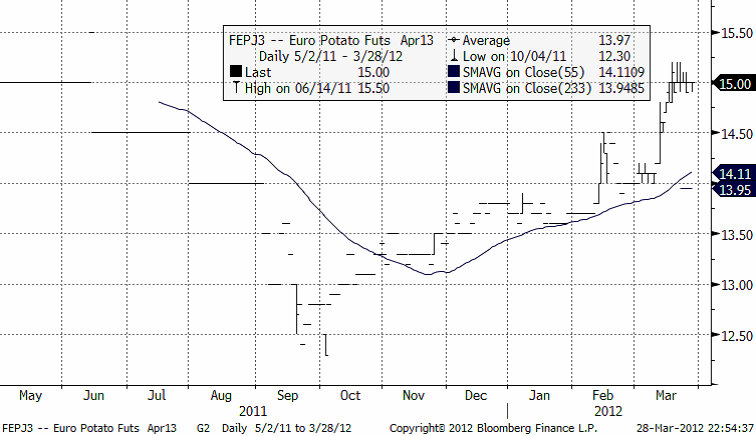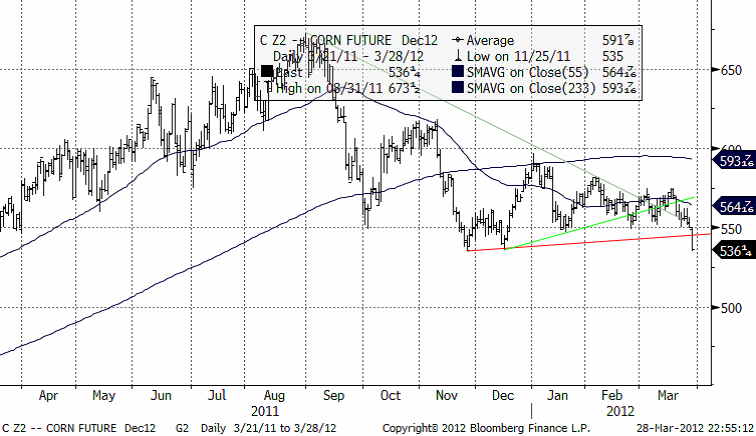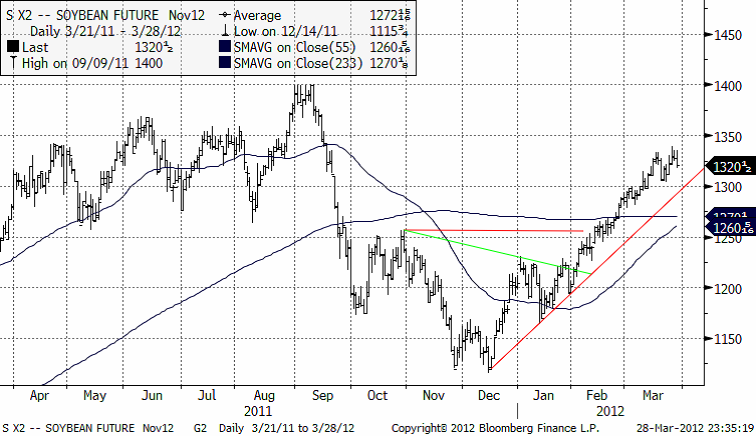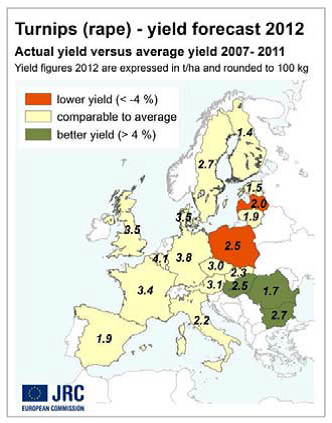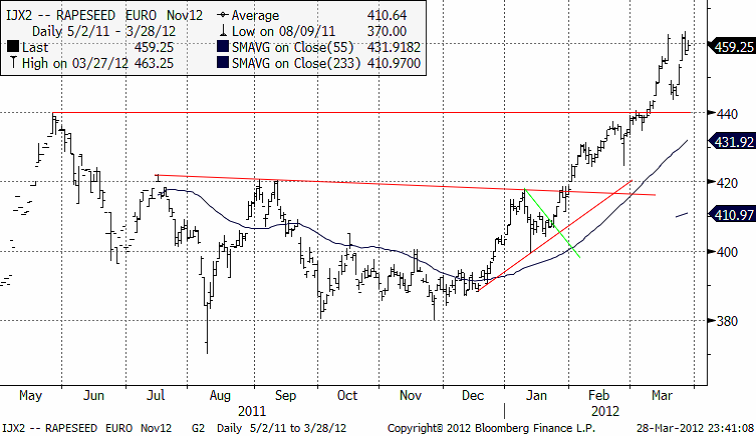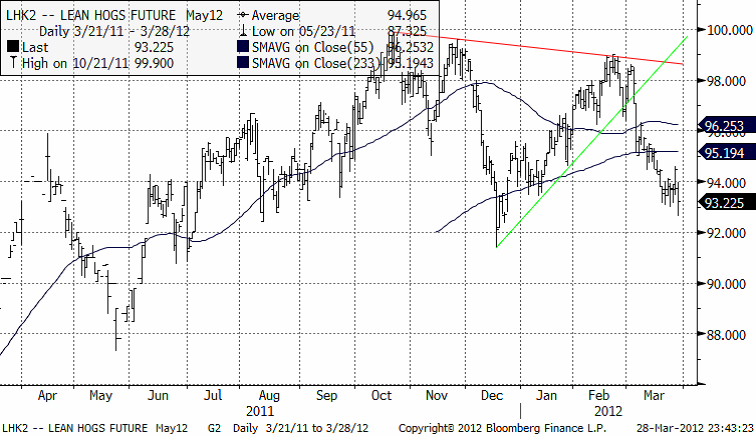Analys
SEB – Jordbruksprodukter, vecka 13 2012
 Majspriset har sjunkit ett par procent men för andra jordbruksprodukter har prisförändringarna den senaste veckan varit en procent som på sin höjd. Sent under onsdagen (igår) föll majspriset genom stödet på 550 cent under starkt säljtryck. Övertygelsen i rörelsen är stark och man bör akta sig för att lockas att ”fyndköpa” spannmål anser vi. Det kan mycket väl bli ett prisfall på spannmål överlag i dagarna som kommer.
Majspriset har sjunkit ett par procent men för andra jordbruksprodukter har prisförändringarna den senaste veckan varit en procent som på sin höjd. Sent under onsdagen (igår) föll majspriset genom stödet på 550 cent under starkt säljtryck. Övertygelsen i rörelsen är stark och man bör akta sig för att lockas att ”fyndköpa” spannmål anser vi. Det kan mycket väl bli ett prisfall på spannmål överlag i dagarna som kommer.
Anledningen till prisfallet är tidiga rapporter om att höstvetet i USA på många håll är i ”enormt mycket bättre skick än förra året”. 75% av Oklahomas och 59% av Kansas vete är i ”good” eller ”excellent” condition.
Imorgon (fredag) kommer USDA:s prospective planting / quarterly stocks. Det blir en spännande dag för majs och sojabönor i synnerhet. Prognosintervallen är ovanligt stora, vilket tyder på stor osäkerhet i marknaden.
Odlingsväder
Southern Oscillation Index, som mäter ENSO och indikerar La Niña om SOI > +8 och El Niño om SOI < -8, har stigit 0,8 enheter till +7.1 i den senaste rapporten från Australiens meteorologiska byrå.
Vete
Novemberterminen på Matif misslyckades med att nå över 210 euro per ton. Den stödlinje som följt uppgången och nu ligger strax under priset, kan brytas under torsdagens eller fredagens handel om prisfallet fortsätter i USA. Crop condition uppskattas i USA att komma in på en högre nivå än novembers sista mätning på 52%. Från Oklahoma rapporteras t ex fenomenalt goda 75% i good / excellent condition. 9 april kommer vårens första crop condition från USDA.
Argentinas veteproduktion för 2012/13 beräknas uppgå till 12 mt. Sådd areal beräknas minska till 4 miljoner hektar, vilket är i nivå med 2009/2010 och den lägsta sedan 1977/78. Enligt USDA är det flera analytiker som räknar med en ännu större nedgång, men många producenter har inga andra alternativ och andra behöver så vete för att med pengar därifrån finansiera produktionen av sojabönor och majs. Regeringen förväntas fortsätta styra den lokala vetemarknaden och reserverar ca 7 mt för det inhemska behovet med möjlig export av överskottet. Producenterna hävdar att detta system gör det svårt att kommersialisera grödan (många har fortfarande vete kvar från tidigare säsonger) och priserna blir också lidande pga bristen på konkurrens mellan lokala kvarnar och exportörer. Det största bortfallet av areal förväntas bli i det rika majsbältet, där producenter troligen föredrar att så sojabönor som första gröda och sedan vete, istället för en dubbel skörd med vete. I centrala och södra Buenos Aires-provinsen förväntas arealen minska marginellt eftersom det där finns färre produktionsalternativ.
Den Europeiska kommissionens analysenhet MARS kom med sin rapport i början på veckan och sammanfattar där att det generellt rådde mildare väder än normalt från början av december fram till de sista dagarna i januari för större delen av Europa. Den högre än normala temperaturen för säsongen under första halvan av vintern gynnade groning och rotskottsstadiet för höstgrödor, men försenade eller hindrade vinterhärdningsprocessen vilket gjorde att dessa grödor utsattes för en högre risk för utvintring.
I västra Europa var grödorna inte alls förberedda och toleranta mot frysgrader och i vissa centrala delar av Europa samt i västra Polen och runt Svarta havet var grödorna endast någorlunda vinterhärdiga. Som en följd av det varma vädret, så var snötäcket obefintligt eller alldeles för tunt i Västeuropa och Polen och även runt Svarta havet samt i ytterligare några regioner i Ukraina när köldknäppen slog till i slutet på januari och temperaturerna sjönk drastiskt, framförallt i centrala och östra Europa. Det tunna snötäcket i t.ex Polen, Tjeckien och runt Svarta havet var inte tillräckligt för att skydda grödorna effektivt under de första dagarna då kylan slog till.
Temperaturen nådde ner till -20 grader i stora områden mellan östra Tyskland och Bulgarien, och längs Polens östra gräns, Slovakien och Rumänien sjönk temperaturen till och med under -25 grader. I början på februari förbättrades dock situationen då snöfall drog in över Ungern, Rumänien, Bulgarien och Balkanhalvön. Några mindre snöfall underlättade också situationen i västra Europa.
Sedan förra månadens rapport har dock ingen ytterligare relevant utvintring konstaterats. Den köldperiod som har orsakat störst skador inträffade under de sista dagarna i januari och i den första halvan av februari. MARS modellsimuleringar indikerar sannolik utvintring i östra Frankrike, Beneluxländerna, Tyskland, Polen, Tjeckien, vissa delar av Rumänien och även i Ukraina (främst runt Krim halvön). Antalet dagar med kritiska temperaturer uppgick till mellan 4 och 9 i dessa områden där betydande bortfall är sannolikt och som nu också bekräftats i bred utsträckning till följd av en ogynnsam utveckling av grödorna som har observerats.
Den låga temperaturen i februari har också lett till en fördröjd fenologisk utveckling i Medelhavsregionen. De milda temperaturer som nu råder i västra och östra Europa är dock gynnsamma för vårbruk och ger lantbrukare möjlighet att besluta om skadade höstgrödor istället ska ersättas med vårgrödor.
Delar av Europa har upplevt bristfällig eller helt utebliven nederbörd, även om den ackumulerade nederbörden översteg genomsnittet i Norge, Finland, Vitryssland, västra Ryssland, Georgien, Grekland, Turkiet, södra Italien och Tunisien i första halvan av mars. Allvarlig brist på regn har sedan december observerats i Spanien, Portugal och Marocko. Vinternederbörden som har registrerats för södra Frankrike, norra Italien och vissa områden i England, Österrike, Slovenien och Ungern samt i södra och östra delarna av europeiska Ryssland ligger under genomsnittet.
Framförallt Spanien och Portugal står inför svåra problem med vattenförsörjningen. Nederbörden över den iberiska halvön uppmättes till 10 mm i mars och torkan fortsätter. Det ackumulerade genomsnittliga underskottet av nederbörd för länderna sedan den 1 oktober visar på 300 mm för Portugal och 155 mm för Spanien och närmar sig därmed de mest extrema åren. Analysen av de mest likartade åren tyder på att denna situation är exceptionell. Vattenunderskottet drabbar merparten av Portugal och regionerna Andalusien, Extremadura och Castilla Y León i Spanien. De milda vintertemperaturerna mildrade dock den aktuella situationen för grödorna något men den låga nivån av vattenreservoarer och tunt snötäcke i bergen förväntas leda till brist på bevattnings möjligheter framöver.
Även om det finns synliga tecken på vattenbrist i södra Frankrike, centrala och norra delen av Italien samt vissa områden i England, Österrike, Slovenien och Ungern, verkar denna situation mindre allvarlig jämfört med den iberiska, men nederbörd är nu mycket önskvärd för dessa regioner.
Eftersom det fortfarande är tidigt på säsongen så baseras MARS prognoser på trender och medelvärden förutom prognoserna för durumvete i Spanien, Portugal och Italien där grödorna är nära blomning. Till följd av torkan i de viktigaste durumveteproducerande regionerna i Spanien, så ligger prognoserna klart under genomsnittet eftersom det inte är möjligt att uppnå full avkastningspotential även om den återstående växtsäsongen blir god.
I bilden nedan visar den röda tonen de synliga jordbruksområdena med en dålig alt försenad start på säsongen, det motsatta gäller för de gröna områdena. På den iberiska halvön syns en ökad negativ säsong med en trend norr – söder. I de norra jordbruksområdena är växtperioden i ett mycket tidigt skede och lider därför inte av den torra vinterperioden medan grödorna i de södra områdena lider av långvarig brist på regn. Situationen har försämrats sedan början av februari och drabbar durumvetets utveckling framförallt i Portugal.
Södra Italien har haft kallare och blötare väderförhållanden än vanligt och utvecklingen av durumvete och starten på säsongen för andra höstgrödor har försenats. Storbritannien och västra Frankrike har gynnats av de milda vintertemperaturerna med en bra start på säsongen för höstgrödorna. I östra Frankrike och västra Tyskland avtog grödornas utveckling efter köldknäppen i februari och orsakade, framförallt i Frankrike, utvintring.
De viktigaste durumveteproducerande regionerna i Tyskland visar dock på en återväxt trots temperaturerna i februari. Olika förhållanden råder bland regionerna på gränsen mellan Tyskland och Polen där vintergrödorna visade en positiv utveckling innan vintervilan, men som nu uppvisar en fördröjning i utvecklingen. I Östeuropa fick grödorna en dålig start på säsongen på grund av den torra hösten och därefter den kraftiga vinterkylan. I Grekland är durumvetets och höstgrödornas utveckling starkt försenad på grund av de ovanligt låga temperaturerna i januari och februari. I Turkiet, Ukraina och Ryssland finns fortfarande ett ihållande snötäcke.
MARS estimerar EU27´s avkastning för den totala veteproduktionen för 2012 till 5.41 t/ha, en liten uppgång jämfört med förra året (5.36 t/ha). Avkastningen för ”mjukt” vete estimeras till 5.67 t/ ha (tidigare 5.58 t/ha) och durumvete estimeras till 3.16 t/ha (tidigare 3.41 t/ha).
Trots i stort sett idealiska förhållanden för sådd av 2012/13 års grödor i Australien, så förväntas arealen för vete och korn att minska jämfört med förra året då lantbrukare istället väljer att producera canola utifrån mer lönsamma priser.
Den totala arealen för sådd av vete för 2012/13 (säsongen börjar oktober 2012) beräknas uppgå till 13.5 miljoner hektar, vilket skulle vara en betydande minskning jämfört med föregående års rekord areal på 14.1 miljoner hektar, men fortfarande i linje med det tio-åriga genomsnittet på 13.21 miljoner hektar (enligt historisk data från ABARES).
Rekordsådden av vete under 2011/12, vilket följde en nästan lika hög sådd året innan, sätter press på vissa lantbrukares växtföljd och därmed gå från veteproduktion till grödor som raps och baljväxter. En kraftig nedgång i de inhemska vetepriserna, jämfört med de mer lönsamma priserna på canola, förväntas också bidra till ökad areal för canola på bekostnad av vete och korn.
Sådden börjar vanligtvis i mitten till slutet av april och fortsätter fram till juni, men de kraftiga regn (och översvämningar) som östra Australien har fått tagit del av kommer sannolikt att möjliggöra en tidigare start där.
Australiens veteproduktion för 2012/13 beräknas uppgå till 27 mt enligt USDA (vilket är något högre än ABARES estimat på 26 mt i början på månaden), en nedgång med ca 6.5% jämfört med rekordproduktionen på 28.9 mt under 2011/12 men fortfarande över genomsnittet.
Estimatet för landets totala veteexport för 2012/13 ligger på 19.5 mt, vilket är en minskning från den reviderade uppskattningen på 20.5 mt från föregående år som anses vara ett historiskt rekord. Nedgång i produktionen och sämre utsikter, delvis driven av en stark australiensisk dollar, förväntas bidra till den minskade exporten.
Nedan ser vi terminskurvorna för Chicagovete och Matif-vete. Notera att marknaden på Matif är kraftigt utökad i löptid, vilket gör det möjligt att tillämpa den effektiva ”trappstegsmetoden” för att prissäkra variation i priser över flera år.
Vi ser prisfall för alla löptider på Chicagobörsen och även samma sak på Matif (augusti 2012 ska man inte titta på, den är för illikvid).
Vi fortsätter att ha en negativ vy på i synnerhet Matifs terminspriser och då särskilt de med kort löptid, de med leverans det närmaste året.
Maltkorn
Novemberkontraktet på maltkorn ligger fortfarande under glidande medelvärden och det brukar tolkas negativt.
Argentinas kornproduktion för 2012/13 förväntas uppgå till 5.4 mt. Producenter ser korn som ett väldigt bra alternativ till vete eftersom regeringen inte lägger sig i handeln med korn. Sådd areal förväntas uppgå till 1.5 miljoner hektar, en ökning med 50 procent, och den högsta nivån de senaste 50 åren. Producenter har haft 2 år på raken med goda kornskördar, höga priser och utan restriktioner i försäljningen. Med förväntade priser och genomsnittlig avkastning, förväntas därför intäkterna att bli högre än för vete. Olika faktorer, bland annat en stark global efterfrågan, en ny marknad i Kina och flertalet stora handelshus som är verksamma på marknaden uppmuntrar lantbrukare att öka arealen.
Korn ger dessutom lantbrukarna en stor fördel eftersom de kan så en andra skörd (vanligtvis sojabönor) två veckor tidigare än om den första grödan är vete. De områden där produktionen förväntas öka är i huvudsak i södra Santa Fe och norr om Buenos Aires. Det råder dock vissa tvivel om att det finns tillräckligt med frön för en sådan stor expansion, men det sägs att lantbrukarna behållit tillräcklig med frön från tidigare säsong.
I Australien förväntas arealen för korn att uppgå till 3.8 miljoner hektar för 2012/13 vilket är en minskning från den estimerade nivån för förra året. Låga priser på foderspannmål och ökad konkurrens från canola ses som bidragande orsaker. Prognosen skulle också anses vara under genomsnittet enligt historisk data från ABARES.
En förväntad avkastning på 2.1 t/ha för 2012/13 är dock den högsta prognostiserade avkastningen på över ett decennium. Produktionen förväntas uppgå till 8.0 mt vilket är en nedgång från estimatet på 8.5 mt för föregående år och med en export prognos på 3.75 mt vilket är något under det reviderade estimatet på 4.0 mt för 2011/12.
Lägre produktion och en historiskt hög Australiensisk dollar är faktorer som påverkar. MARS estimerar EU27´s avkastning för den totala korn produktionen för 2012 till 4.41 t/ha, en liten uppgång jämfört med förra året (4.30 t/ha). Avkastningen för vårkorn estimeras till 3.88 t/ ha (tidigare 3.81 t/ha) och höstkorn estimeras till 5.24 t/ha (tidigare 5.06 t/ha).
Potatis
Priset på industripotatis för leverans nästa år tog en paus efter förrförra veckans kraftiga prisuppgång. Priset har 15 euro som fixpunkt för den aktuella handeln.
Majs
Majspriset föll igår kväll genom stödet på 550 cent / bushel. Säljsignalen går inte att missa. Priset bör rimligen kunna gå ner till 500 cent nu på kort tid. På fredag publicerar USDA statistik på lager och förväntad areal i år. En survey gjord av AgView där lantbrukare tillfrågats om sina lager, inplicerar lager på 1.8 mbu (mot 3.8 mbu förra året). Denna information kom tidigare i veckan. Marknaden har alltså svalt detta och ändå gått ner.
Marknadens nyfunna momentum – nedåt – indikerar ett starkt och övertygat säljtryck. Detta är antagligen det ”utbrott” från konsolideringsfasen som marknaden väntat på.
Sojabönor
Efter förra veckans veckobrev gick sojabönspriset först upp, men började veckan med att stå till och föll så under onsdagen, tillsammans med andra jordbruksprodukter. Sojamjölet står dock fortfarande på plus sedan förra veckan.
Raps
MARS estimerar EU27´s avkastning i rapsproduktionen för 2012 till 3.02 t/ha, en uppgång jämfört med förra årets 2.88 t/ha.
Nedan ser vi kursdiagrammet för novemberkontraktet.
440 euro utgör nu, när den nivån är bruten, ett tekniskt stöd. Vi fortsätter därför att ha en neutral vy, om inte 440-nivån bryts igen.
Gris
Majkontraktet står faktiskt på exakt samma pris som det gjorde för en vecka sedan. Däremellan har det däremot rört sig både över och under den nivån. Priset föll under gårdagen (onsdagen) ganska kraftigt men stängde över dagens lägsta notering. Förmodligen är inte fallrisken så stor i dagsläget. Stöd finns redan på 92 cent per pund. På lite längre sikt, i synnerhet om majspriset faller, ”borde” grispriset följa efter.
[box]SEB Veckobrev Jordbruksprodukter är producerat av SEB Merchant Banking och publiceras i samarbete och med tillstånd på Råvarumarknaden.se[/box]
Disclaimer
The information in this document has been compiled by SEB Merchant Banking, a division within Skandinaviska Enskilda Banken AB (publ) (“SEB”).
Opinions contained in this report represent the bank’s present opinion only and are subject to change without notice. All information contained in this report has been compiled in good faith from sources believed to be reliable. However, no representation or warranty, expressed or implied, is made with respect to the completeness or accuracy of its contents and the information is not to be relied upon as authoritative. Anyone considering taking actions based upon the content of this document is urged to base his or her investment decisions upon such investigations as he or she deems necessary. This document is being provided as information only, and no specific actions are being solicited as a result of it; to the extent permitted by law, no liability whatsoever is accepted for any direct or consequential loss arising from use of this document or its contents.
About SEB
SEB is a public company incorporated in Stockholm, Sweden, with limited liability. It is a participant at major Nordic and other European Regulated Markets and Multilateral Trading Facilities (as well as some non-European equivalent markets) for trading in financial instruments, such as markets operated by NASDAQ OMX, NYSE Euronext, London Stock Exchange, Deutsche Börse, Swiss Exchanges, Turquoise and Chi-X. SEB is authorized and regulated by Finansinspektionen in Sweden; it is authorized and subject to limited regulation by the Financial Services Authority for the conduct of designated investment business in the UK, and is subject to the provisions of relevant regulators in all other jurisdictions where SEB conducts operations. SEB Merchant Banking. All rights reserved.
Analys
Tightening fundamentals – bullish inventories from DOE

The latest weekly report from the US DOE showed a substantial drawdown across key petroleum categories, adding more upside potential to the fundamental picture.

Commercial crude inventories (excl. SPR) fell by 5.8 million barrels, bringing total inventories down to 415.1 million barrels. Now sitting 11% below the five-year seasonal norm and placed in the lowest 2015-2022 range (see picture below).
Product inventories also tightened further last week. Gasoline inventories declined by 2.1 million barrels, with reductions seen in both finished gasoline and blending components. Current gasoline levels are about 3% below the five-year average for this time of year.
Among products, the most notable move came in diesel, where inventories dropped by almost 4.1 million barrels, deepening the deficit to around 20% below seasonal norms – continuing to underscore the persistent supply tightness in diesel markets.
The only area of inventory growth was in propane/propylene, which posted a significant 5.1-million-barrel build and now stands 9% above the five-year average.
Total commercial petroleum inventories (crude plus refined products) declined by 4.2 million barrels on the week, reinforcing the overall tightening of US crude and products.


Analys
Bombs to ”ceasefire” in hours – Brent below $70

A classic case of “buy the rumor, sell the news” played out in oil markets, as Brent crude has dropped sharply – down nearly USD 10 per barrel since yesterday evening – following Iran’s retaliatory strike on a U.S. air base in Qatar. The immediate reaction was: “That was it?” The strike followed a carefully calibrated, non-escalatory playbook, avoiding direct threats to energy infrastructure or disruption of shipping through the Strait of Hormuz – thus calming worst-case fears.

After Monday morning’s sharp spike to USD 81.4 per barrel, triggered by the U.S. bombing of Iranian nuclear facilities, oil prices drifted sideways in anticipation of a potential Iranian response. That response came with advance warning and caused limited physical damage. Early this morning, both the U.S. President and Iranian state media announced a ceasefire, effectively placing a lid on the immediate conflict risk – at least for now.
As a result, Brent crude has now fallen by a total of USD 12 from Monday’s peak, currently trading around USD 69 per barrel.
Looking beyond geopolitics, the market will now shift its focus to the upcoming OPEC+ meeting in early July. Saudi Arabia’s decision to increase output earlier this year – despite falling prices – has drawn renewed attention considering recent developments. Some suggest this was a response to U.S. pressure to offset potential Iranian supply losses.
However, consensus is that the move was driven more by internal OPEC+ dynamics. After years of curbing production to support prices, Riyadh had grown frustrated with quota-busting by several members (notably Kazakhstan). With Saudi Arabia cutting up to 2 million barrels per day – roughly 2% of global supply – returns were diminishing, and the risk of losing market share was rising. The production increase is widely seen as an effort to reassert leadership and restore discipline within the group.
That said, the FT recently stated that, the Saudis remain wary of past missteps. In 2018, Riyadh ramped up output at Trump’s request ahead of Iran sanctions, only to see prices collapse when the U.S. granted broad waivers – triggering oversupply. Officials have reportedly made it clear they don’t intend to repeat that mistake.
The recent visit by President Trump to Saudi Arabia, which included agreements on AI, defense, and nuclear cooperation, suggests a broader strategic alignment. This has fueled speculation about a quiet “pump-for-politics” deal behind recent production moves.
Looking ahead, oil prices have now retraced the entire rally sparked by the June 13 Israel–Iran escalation. This retreat provides more political and policy space for both the U.S. and Saudi Arabia. Specifically, it makes it easier for Riyadh to scale back its three recent production hikes of 411,000 barrels each, potentially returning to more moderate increases of 137,000 barrels for August and September.
In short: with no major loss of Iranian supply to the market, OPEC+ – led by Saudi Arabia – no longer needs to compensate for a disruption that hasn’t materialized, especially not to please the U.S. at the cost of its own market strategy. As the Saudis themselves have signaled, they are unlikely to repeat previous mistakes.
Conclusion: With Brent now in the high USD 60s, buying oil looks fundamentally justified. The geopolitical premium has deflated, but tensions between Israel and Iran remain unresolved – and the risk of missteps and renewed escalation still lingers. In fact, even this morning, reports have emerged of renewed missile fire despite the declared “truce.” The path forward may be calmer – but it is far from stable.
Analys
A muted price reaction. Market looks relaxed, but it is still on edge waiting for what Iran will do

Brent crossed the 80-line this morning but quickly fell back assigning limited probability for Iran choosing to close the Strait of Hormuz. Brent traded in a range of USD 70.56 – 79.04/b last week as the market fluctuated between ”Iran wants a deal” and ”US is about to attack Iran”. At the end of the week though, Donald Trump managed to convince markets (and probably also Iran) that he would make a decision within two weeks. I.e. no imminent attack. Previously when when he has talked about ”making a decision within two weeks” he has often ended up doing nothing in the end. The oil market relaxed as a result and the week ended at USD 77.01/b which is just USD 6/b above the year to date average of USD 71/b.

Brent jumped to USD 81.4/b this morning, the highest since mid-January, but then quickly fell back to a current price of USD 78.2/b which is only up 1.5% versus the close on Friday. As such the market is pricing a fairly low probability that Iran will actually close the Strait of Hormuz. Probably because it will hurt Iranian oil exports as well as the global oil market.
It was however all smoke and mirrors. Deception. The US attacked Iran on Saturday. The attack involved 125 warplanes, submarines and surface warships and 14 bunker buster bombs were dropped on Iranian nuclear sites including Fordow, Natanz and Isfahan. In response the Iranian Parliament voted in support of closing the Strait of Hormuz where some 17 mb of crude and products is transported to the global market every day plus significant volumes of LNG. This is however merely an advise to the Supreme leader Ayatollah Ali Khamenei and the Supreme National Security Council which sits with the final and actual decision.
No supply of oil is lost yet. It is about the risk of Iran closing the Strait of Hormuz or not. So far not a single drop of oil supply has been lost to the global market. The price at the moment is all about the assessed risk of loss of supply. Will Iran choose to choke of the Strait of Hormuz or not? That is the big question. It would be painful for US consumers, for Donald Trump’s voter base, for the global economy but also for Iran and its population which relies on oil exports and income from selling oil out of that Strait as well. As such it is not a no-brainer choice for Iran to close the Strait for oil exports. And looking at the il price this morning it is clear that the oil market doesn’t assign a very high probability of it happening. It is however probably well within the capability of Iran to close the Strait off with rockets, mines, air-drones and possibly sea-drones. Just look at how Ukraine has been able to control and damage the Russian Black Sea fleet.
What to do about the highly enriched uranium which has gone missing? While the US and Israel can celebrate their destruction of Iranian nuclear facilities they are also scratching their heads over what to do with the lost Iranian nuclear material. Iran had 408 kg of highly enriched uranium (IAEA). Almost weapons grade. Enough for some 10 nuclear warheads. It seems to have been transported out of Fordow before the attack this weekend.
The market is still on edge. USD 80-something/b seems sensible while we wait. The oil market reaction to this weekend’s events is very muted so far. The market is still on edge awaiting what Iran will do. Because Iran will do something. But what and when? An oil price of 80-something seems like a sensible level until something do happen.
-

 Nyheter4 veckor sedan
Nyheter4 veckor sedanUppgången i oljepriset planade ut under helgen
-

 Nyheter3 veckor sedan
Nyheter3 veckor sedanMahvie Minerals växlar spår – satsar fullt ut på guld
-

 Nyheter4 veckor sedan
Nyheter4 veckor sedanLåga elpriser i sommar – men mellersta Sverige får en ökning
-

 Nyheter2 veckor sedan
Nyheter2 veckor sedanOljan, guldet och marknadens oroande tystnad
-

 Analys4 veckor sedan
Analys4 veckor sedanVery relaxed at USD 75/b. Risk barometer will likely fluctuate to higher levels with Brent into the 80ies or higher coming 2-3 weeks
-

 Nyheter2 veckor sedan
Nyheter2 veckor sedanJonas Lindvall är tillbaka med ett nytt oljebolag, Perthro, som ska börsnoteras
-

 Analys3 veckor sedan
Analys3 veckor sedanA muted price reaction. Market looks relaxed, but it is still on edge waiting for what Iran will do
-

 Nyheter2 veckor sedan
Nyheter2 veckor sedanDomstolen ger klartecken till Lappland Guldprospektering


